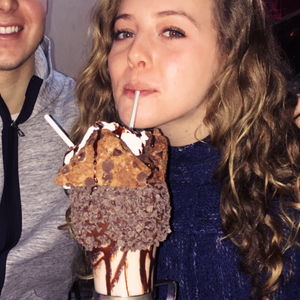Sitting in a doctor’s office, scantily clad in a blue cloth, waiting to be seen. Bright and cheery, the doctor comes in and begins to examine your body. You always thought of your little moles are cute and something that reminds you of your past summers. A new one pops up here and there in the winter and it reminds you of warmer times when the mole is surrounded by freckles. The doctor stops at the little one right below your collar bone and he pauses. Then the docotor takes out his magnifying scope that looks like a super high tech eye glass. The doctor calls for the nurse to take a picture of your mole, saying its shape isn’t quite like the rest of your moles and it has a strange dotted pattern.
He finds two more that aren’t quite like the rest and schedules you for a surgery. You shrug off the possible concerns. You are only a young adult. Your skin is just too young to have any problems besides a pimple.
The surgery is an easy procedure. You come into the office, are numbed with a little shot and then the doctor scraps away the mysterious mole, sending it away to a lab
You go on with your next few days, quickly forgetting about the bandaids that cover your removal. The doctor calls within days saying he’d like you to come back into the office to discuss the lab report. With some concern, you schedule an appointment within the same week.
The doctor explains that your moles had atypical cells, meaning that the moles were not healthy and could potentially lead to skin cancer. Skin cancer? What? He tells you it’s not exactly a pressing issue now but in twenty years or so your increased risk of melonimia is increased.
Now imagine you are only in fourth grade. And you get an innoncent mole with a halo like circle around it removed. Then image in fifth grade you get five more moles removed, this time in a surgical center under anaesthesia. Fast-forward to ninth grade when four more come off. Next, we move to seventeen when you have seven more taken off and you begin to lose track how many scars are on your body. Switching doctors to a newer method of treatment. Now at age eighteen, you have more removed. Then at nineteen, two removed on your scalp, not on your part line but covered by thick hair and you were pretty sure that the sun didn’t shine there. But the sun also didn’t shine on your nipple when you had a mole removed there in fifth grade. Formally diagnosed with dysplastic nevi. A skin condition where moles have Atypical cells that are begnin, or noncancerous. However, this condition usually means the person has an increased risk for melanoma. A skin cancer that eventually leads to death. That’s a lot to hang on the back of an almost twenty year old.
That’s me.
I’m under close watch by two different doctors. I am reassured if the problem is contained and I protect myself, it’s not an issue that should worry me. However, I must be careful with time in the sun, wear hats and protective sunscreen, reapplying often and being dilligent with my skin. This is not just for prevention, this is for protection and to get a problem contained.
The good news is that right around my age, mole production peaks and then slows down and the moles I have will be kept on close watch but new moles popping up should be less than in my teenage years. That’s why it is so important to protect your young skin in its most vulnerbale years.
Your family’s skin plays a role in dysplastic nevi. If they have had this skin condition then their children at a high risk. My mother has dysplastic nevi and squamous cell carcinoma and my father had been treated for basal cell carcinoma. All of these cancers are treatable when diagnosed early. However, they do point to risks of more serious skin cancers. Even if no one in your family suffers from skin cancer, sun protection is extremely important to your health. According to the Skin Cancer Foundation, lighter-skinned people have the highest risk of dysplastic nevi, around 2-8 percent of the white population have atypical moles. The American Caner Society warns that even darker-skinned people can develop skin cancers from sun exposure.
UV damage is the leading cause of skin cancer.
That includes artificial tanning, such as tanning beds, and natural UV from the sun. No tan is a healthy tan. The change in color comes from increased activity and number of cells that make the pigment of your skin. This pigment is called melanin that can protect your skin from UV damage to a point. That’s why darker-skinned people typically get fewer sunburns than lighter-skinned people. So that healthy glow isn’t actually so healthy. And doesn’t everyone say a base tan will protect you from getting a sunburn on vacation? The opposite actually. According to the Melanoma Research Foundation, a “base tan” is the equivalent protection of SPF 3
Aside from preventing wrinkles, age spots, and premature aging, sunscreen protects against your life in a sense. You’ll be grateful for your sunscreen use when you are older in spirit but wrinkle-free in appearance. All that is not to say, the sun is not to be feared like Howie from the Benchwarmers. The sun is a natural source of vitamin D and a daily dose of sun is good for you.


